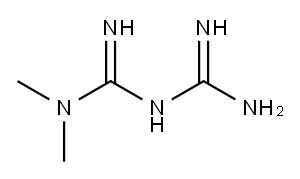Metformin: Mechanisms in Targeting Biological Aging and its Side Effects
Dec 6,2024
General Description
Metformin, a commonly prescribed antihyperglycemic medication, has gained attention for its potential in targeting biological aging beyond glycemic control. Its multifaceted mechanisms involve inhibiting hepatic glucose production, enhancing insulin sensitivity, and modulating pathways related to metabolism, oxidative stress, and inflammation. By activating AMP-activated protein kinase (AMPK) and influencing mitochondrial function, metformin plays a crucial role in regulating cellular processes associated with aging. While generally well-tolerated, metformin can cause gastrointestinal discomfort and, rarely, serious conditions like metformin-associated lactic acidosis. Monitoring for side effects and considering individual risk factors are essential when utilizing metformin for managing diabetes and potentially addressing aging-related processes.

Figure 1. Metformin
Mechanisms in Targeting Biological Aging
Metformin was introduced to the world in 1957, as an antihyperglycemic agent by the French physician Jean Sterne, and today, it has become one of the most commonly used pharmaceutical interventions and the most prescribed glucose-lowering medication worldwide. Indeed, it is important to note that metformin does not cause hypoglycemia per se but rather reduces hepatic glucose production through improved hepatic insulin sensitivity, which results in the reduction of fasting plasma glucose levels. Furthermore, with the epidemiological, preclinical, and clinical evidence of metformin exhibiting beneficial effects beyond glycemic control in diabetics, it has been suggested to be repurposed against cancer and its recurrence, cardiovascular disease, neurodegenerative diseases, autoimmune diseases, and most recently, systemic aging as a whole. Despite such widespread use and efficacy, the mechanisms by which metformin regulates fundamental pathways in aging and diseases are not fully elucidated. Metformin’s antihyperglycemic role is attributed to its action on glucose metabolism, specifically as a suppressor of hepatic gluconeogenesis by inhibiting mitochondrial glycerophosphate dehydrogenase, thereby modifying the hepatocellular redox state to reduce glucose formation from lactate and glycerol. On the other hand, metformin’s suppression of hepatic glucose production is shown to be the result of AMP-induced inhibition of fructose-1,6-bisphosphatase-1, a rate-controlling enzyme in gluconeogenesis. In addition to these mechanisms, metformin’s metabolic action includes a reduction in glucose absorption in the intestine, restoring insulin secretion in pancreatic beta cells and to a lesser extent increasing insulin-mediated glucose uptake in the peripheral tissues of muscle and adipose.1
Side Effects
Metformin is off patent, comparatively inexpensive and has proved to be a safe drug for long-term use and, unlike phenformin, its use is associated with a low risk of lactic acidosis, which is minimized when avoided in patients with liver disease, or severely reduced kidney function. The most common side effects are dose-related gastrointestinal (GI)-related (nausea, vomiting, bloating and diarrhea) and with minimal problems with patient compliance estimated at only 5%. The usual dose-range for metformin is from 250 to 2550 mg/day with plasma levels ranging from approximately 5 to 20 μM. Compliance, however, may be much lower than previously considered as a retrospective cohort study of 15,981 patients indicated 48% became non-adherent within the first year of treatment with metformin. Discontinuance of metformin is primarily attributed either to side effects, or glycemic control being achieved independent of pharmacotherapy.
Similarly, a 2018 report indicated that 30% of prescribed doses of metformin were not taken, whereas higher adherence was seen for sulfonylureas, diphenyly-peptide-4 inhibitors (DPP-4 inhibitors, or gliptins) and sodium-glucose co-transport inhibitors-2 (SGLT-2, or gliflozins), but not for glucagon-like peptide-1 receptor agonists (GLP-1 receptor agonists). In the latter study it was noted that whereas DPP-4 inhibitors were generally well-tolerated, GI side effects were more frequently associated with metformin and attributed to the lower adherence with the biguanide. Based on these data, patient compliance might prove to be a deterrent should metformin be re-purposed for prophylactic purposes such as an anti-aging drug. The chronic use of metformin can also result in vitamin B12 deficiency due to malabsorption in from 6% to up to 30% of patients and possibly linked to changes in the microbiota, altered motility, and/or alterations in the calcium-dependent transport via the gastric intrinsic factor glycoprotein. Vitamin B12 deficiency could offset putative benefits associated with using metformin for the treatment of neurodegenerative diseases. Concerns over reproductive health in males have also been raised and are discussed in the conclusions section together with the risk of environmental contamination. Metformin is also being increasingly used in gestational diabetes and is considered a safe alternative to insulin. Unlike insulin, metformin crosses the placenta and will also be transferred to the newborn via the mother's breast milk and there is evidence that metformin may have effects on postnatal growth as suggested by data from the Metformin in Gestational diabetes (MiG) trial.2
Reference
1. Kulkarni AS, Gubbi S, Barzilai N. Benefits of Metformin in Attenuating the Hallmarks of Aging. Cell Metab. 2020; 32(1): 15-30.
2. Triggle CR, Mohammed I, Bshesh K, et al. Metformin: Is it a drug for all reasons and diseases?. Metabolism. 2022; 133: 155223.
- Related articles
- Related Qustion
- New Study Reveals Genetic Polymorphisms Affecting Metformin Efficacy Dec 27, 2023
Metformin's pharmacokinetics involve active cellular uptake through transporters. Genetic polymorphisms in cation transporters influence its effectiveness and clearance.
- Metformin: Activity, Pharmacodynamics, Mechanisms and Application Studies Mar 3, 2023
The metformin is biguanide containing two coupled molecules of guanidine with additional substitutions. It has been widely used to treat diabetes since the 1950s.
1,7-Dimethylxanthine is a naturally occurring alkaloid compound that can enhance alertness and reduce drowsiness.....
Feb 27,2025APILuteolin, a natural compound with antioxidant and anticancer properties, shows promise in inhibiting cancer progression in breast and prostate cancer through various mechanisms....
Apr 30,2024API








